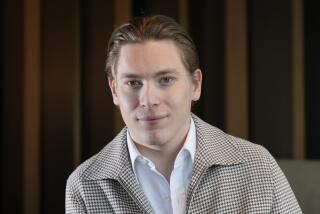The Dutch embrace Messiaen
AMSTERDAM -- There have been some things even the most dazed Dutch, hazy-headed from the legal hash and marijuana sold in “coffee shops,” probably couldn’t have missed this month in their teeming capital. Construction is everywhere, especially along the docklands development that includes the astonishing new Muziekgebouw (a concert hall complex devoted to new music!). By day, more bicyclists than ever rule the streets, blissfully independent of Royal Dutch Shell, the national oil company. By night, soccer fans have turned the town squares orange on Euro 2008 match nights, with seemingly all of the populace dressed in Holland’s team color.
In music, meanwhile, Messiaen has been manifest. The world is celebrating the 100th anniversary of the French composer’s birth this year, but nowhere as extravagantly as here. This month at the Concertgebouw, the celebrated main concert hall, the Royal Concertgebouw Orchestra performed his first great orchestral work (“L’Ascension”), his last (“Éclairs sur l’Au-delà”) and his most famous (the “Turangalîla” Symphony). The Radio Philharmonic took on the evening-long “La Transfiguration de Notre Seigneur Jésus-Christ.” Dutch pianist Ralph van Raat played “Vingt regards sur L’Enfant-Jésus.” Messiaen’s organ music was heard around town. And the Netherlands Opera produced his glorious epic opera, “Saint François d’Assise” -- gloriously.
Ecstatic composer
Why the Dutch have taken to this eccentric composer besotted by birds and mystical Catholicism is anyone’s guess. But Amsterdam’s enlightened accommodation of innovation and tradition, to say nothing of its acceptance of unconventionality, may have something to do with the city’s fervent embrace of Messiaen.
In the early ‘50s, Messiaen moved music forward with his formalized explorations of pitch and rhythmic structure, something that could possibly appeal to a country of builders as well as dreamers. He was a composer who readily entered into states of ecstasy, erotic and spiritual, both of which the Dutch also appear to be very good at. As for birds, head into the countryside on a bike trail here and surprisingly loud and varied avian serenades will be your soundtrack.
I caught the tail end of this Messiaen merriment -- a performance of “Turangalîla” and the last performance of “Saint François,” both offerings of this year’s Holland Festival, which concluded Sunday.
The symphony didn’t go well. Mariss Jansons, the revered Latvian music director of the Concertgebouw, was to have conducted. But after six rehearsals and what was reported to be a ravishing first performance of the orgiastic 75-minute symphony Thursday night, he collapsed from exhaustion and had to relinquish the remaining two performances. Friday night, when I attended, an orchestra trumpet player and assistant conductor, Theo Wolters, stepped in with no rehearsal and essentially just beat time.
“Saint François,” on the other hand, was a triumph two days later. The Dutch enjoy a special relationship with this opera, which is more than five hours long and has next to no action. The central scene is St. Francis preaching, for some 45 minutes, to the birds -- and that comes at the end of a two-hour second act. It takes him an additional hour to die in the last act.
‘Saint François’ inspires
The opera’s premiere in 1983 in Paris was viewed as an old man’s self-indulgence. However, a concert performance in the Dutch city of Utrecht three years later made a strong case for the music. At the 1992 Salzburg Festival, a production by Peter Sellars -- which was conducted by Esa-Pekka Salonen and featured the Los Angeles Philharmonic -- finally proved the opera’s stage-worthiness.
Amsterdam’s inspired staging was by Pierre Audi, who heads both Netherlands Opera and the Holland Festival. It starred Rod Gilfry as an intense St. Francis, in what was clearly the performance of the Southern California baritone’s career. Camilla Tilling was the Angel, with a voice that sounded in direct contact with heaven. Ingo Metzmacher conducted the Hague Philharmonic, which was seated on the stage and filled the Muziektheater with brilliance.
An abstract set, designed by Jean Kalman and inspired by the sculpture of Christian Boltanski, was placed in front of the musicians. Most of the acting was understated, Zen-like in its focus. Francis preached not to birds but young schoolchildren, and time flew as the stage was spread with joy.
But that was the end of joy. Sunday was a two-saints day. In the evening, the festival ended with the Netherlands premiere of Osvaldo Golijov’s “La Pasión Según San Marcos.”
As Messiaen did to Francis, Golijov turned to the Evangelist Mark as an example of transcending the fear of death, only Golijov portrayed him using the idioms of Latin music and dance. The Netherlands’ crown prince and princess attended this “Pasión” in the Carré, a former circus venue. Deutsche Grammophon filmed it for DVD release next Easter. Dutch television broadcast it live and also beamed it into one of Amsterdam’s parks.
Golijov is not as easy a sell in Holland as Messiaen. I was taken aback by such phrases as “Golijov as sponge” and “Long live contamination” in the program book (which was in English and Dutch), but Robert Spano led a fluid performance, the score worked its usual magic, and the audience seemed plenty happy if not, as after “François,” transformed.
More to Read
The biggest entertainment stories
Get our big stories about Hollywood, film, television, music, arts, culture and more right in your inbox as soon as they publish.
You may occasionally receive promotional content from the Los Angeles Times.







